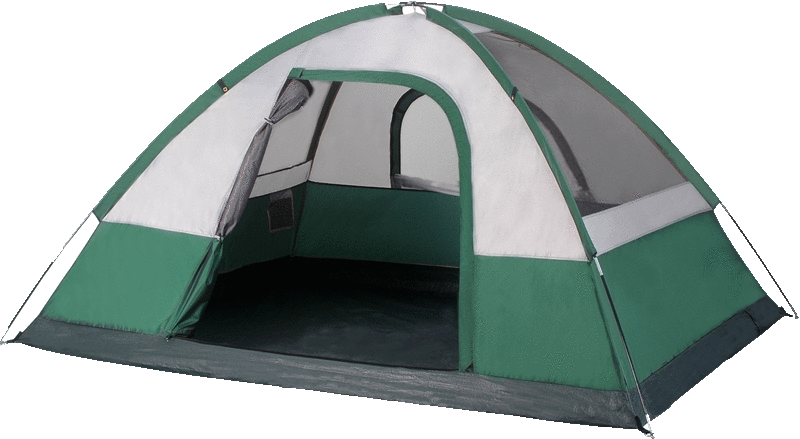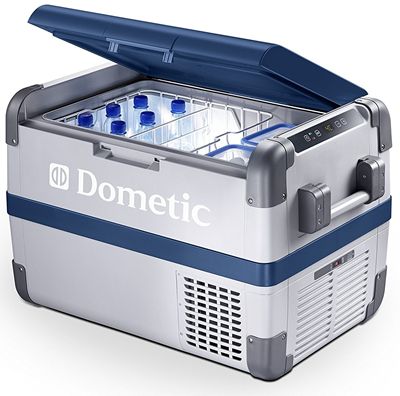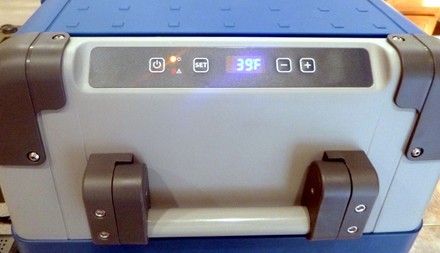In recent years, expensive “roto-molded” coolers like the Yeti have become quite
popular. They have thick insulation and very effective gaskets which keep the
cold inside for a longer period of time than standard coolers. In a standard
cooler your ice will typically all melt in three to four days. A Yeti or other
roto-molded super-cooler is said to be able to hold your ice for a week or more.
But Yeti recommends using a number of special techniques to maximize your
ice-holding, such as pre-cooling your cooler, preferably in a walk-in freezer
for a day or two before use. Then place your ice in a layer at the bottom of
the cooler, with a layer of closed-cell foam (like backpacker sleeping pad
material) on top of the ice to further insulate it. Then in use, only open
your cooler once or twice a day. Really???
I never could wrap my head around spending that kind of money on a cooler,
then being very limited in the amount of stuff you could put into it due to
the very thick walls and because two thirds of the volume is taken up by ice
(standard Yeti recommendation).
This year I drew tags for both elk and deer, and the hunts are back-to-back.
That means that I will be living out of my camping trailer for up to
two-and-a-half straight weeks. Knowing this, I asked my family for a special
birthday present. They all chipped in and got me a super-cooler that is
actually even more expensive than a similarly-sized Yeti. But this cooler
is not subject to all the special handling tricks and use limitations
imposed by those roto-molded super-coolers. But is it a “cooler”? Well no,
it is not an ice-box. It’s actually a DC refrigerator.
Though my little A-frame camping
trailer is equipped with a 3-way refrigerator (AC-DC-propane), it is a
typical ammonia-absorption type of RV refrigerator. A refrigerator of this
type has its own limitations.
First is the well-known need to perfectly level your trailer, or it doesn’t
work so well. Second, mine seems to take forever to cool-down after start up.
Several times I have put food in the fridge expecting the food to be
adequately chilled, only to find to my horror that the temperature wasn’t all
that cold, maybe 60°. Other times, I have grabbed a soda out of it, popped
the top, only to find a slushie because the temperature was too cold.
Lighting it on propane was always a pain. You have to push the button to
trigger the ignitor, then hold it for several minutes to make sure that the
gas is flowing and it will stay lit.
Finally, you cannot pack an RV refrigerator like this all the way full. You
need to leave room around your food items for air to circulate for the fridge
to properly maintain temperature. Some folks with my type of camper actually
put a computer fan inside to make sure that the air is circulating.
When I added 200 watts of solar panels to the trailer, running a
compressor-driven DC refrigerator like the Dometic CFX-50 was in the plan
all along. The CFX-50 uses the same kind of compressor-driven cooling system
as your home fridge or your air-conditioner. The tiny compressor in the
CFX-50 is made by a German company named Danfoss, and it is very efficient.
In contrast to the RV fridge, the cooler-like form-factor of the CFX-50 as a
chest instead of a cabinet also aids efficiency by keeping the cold air in
when it is opened.
The CFX-50 can be run from either AC or DC. It comes with two cables that
plug into two different power ports in the back. There is a digital control
panel on one end that allows you to precisely set the temperature in 1°C or
2°F temperature increments. You can actually run it as a freezer if you
want to because the temperature is settable over the range from -8° F to
+50°F.
In DC operation, there is a function which allows you to set a cutoff
voltage to stop the fridge from running if the DC voltage is too low.
This is to prevent over-discharge of a vehicle’s starter battery.
As I write this review, I have only used the CFX-50 over one night in
the trailer. That was on the opening weekend for dove. My son Ben and
I drove out to a large cattle pond in the western desert the evening before,
so that we could be ready to hunt at first light without suffering too much
from sleep deprivation.
When we went to bed for the night, the trailer’s battery voltage read 12.6
volts. When we awoke the next morning, the voltage read 12.4 volts. Not
bad at all. The compressor is very quiet and runs only intermittently.
We hunted until about 10am because the heat was really coming on by then.
It was so great to be able to pull cold sodas out of the fridge when we got
back to the trailer. Ok, yeah, for less than one day, an ice cooler would
have worked as well, but at least the cans were not wet!
On the drive out and back, we hosted the CFX-50 in the back seat of the truck.
We plugged it into a 12V power socket which is available at the rear of the
center console between the two front seats. That meant we could grab a cold
pop anytime we wanted one while on the road.
Another big advantage of the CFX-50 over a Yeti or an RV fridge, is that all
the volume is available for food. There is no ice taking up precious space,
nor do you need to leave air space around your food items. The more you pack
into it, the better it works because the thermal mass of the food items helps
to hold your temperature.
This brings us to the biggest downside. The empty CFX-50 by itself weighs 45
pounds. Pack it full of liquids and you could reach 100 total pounds of weight!
The CFX-50 actually has 46 liters of internal volume. Dometic says that you
can pack up to 72 12-ounce cans of soda into it. 72 cans will weigh 56 pounds
for the liquid alone. I would kill myself trying to lift this thing fully loaded!
But we can take advantage of the fact that it is a refrigerator, not an ice box.
For an ice box, you want to make sure that you pre-cool, not only the cooler
itself, but the contents, to stretch your ice as far as possible. With the
CFX-50, I could transport drinks separately in a non-insulated dry-box, then
load them into the fridge at camp as needed. During transport, the fridge would
only need to be loaded with foods that must always stay chilled.
Having solar power is what makes this a viable solution for a hunt camp in the
boonies. Without power, it makes no sense. I needed to answer the question for
myself, “What is the typical 24-hour power consumption of this thing?” “Do I
really have enough power generation and battery storage capacity to run it
indefinitely?”
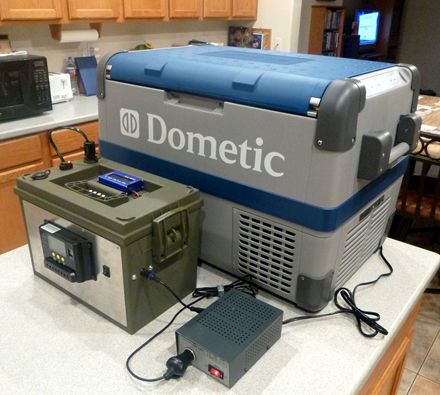
24-hour power consumption test setup
|
Of course I already had a good idea that I could, but I needed to know the
actual numbers, so I set up an experiment in the kitchen. I about half-filled
the CFX-50 with food and drinks from the house refrigerator, and powered it
with 12VDC from a home-made solar power pack. For the test, I kept the power
pack charged from a Radio Shack power supply instead of from a solar panel.
The goal was to measure the total power consumed by the CFX-50 over a 24 hour
period. The solar power pack is equipped with a DC watt-meter which measures
out-going power so that I could make this measurement.
The results were pretty interesting. I started by bringing the CFX-50 into
the house from storage in the garage. When I first turned it on, the
temperature read 96°. It quickly cooled down to 39° in about 20 minutes. I
let it run for an additional hour empty, then set the temperature to 37° and
loaded the food into it. Ambient temperature in the house was 78°. I started
the test at 6:00 PM.
For the next several hours, I recorded the power consumed on the hour, then
went to bed. In the morning, I made another measurement, went to work, took
another measurement at lunch time, then took some more measurements after
coming home from work, terminating the test at 6 PM, 24 hours after starting
the test.
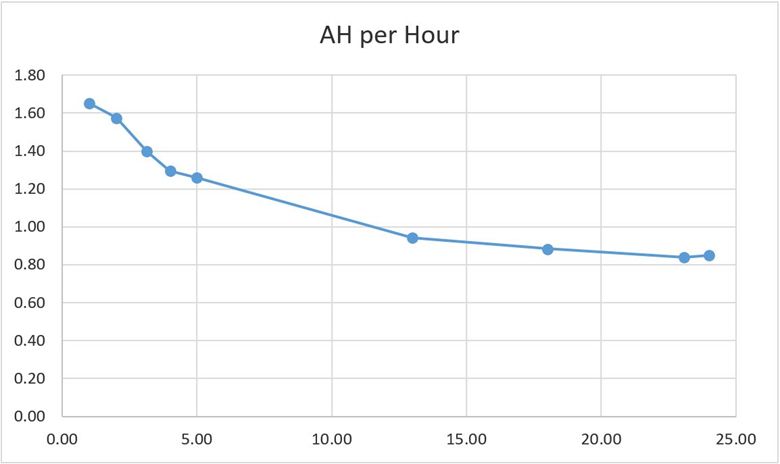
This chart shows that the power consumed per hour started somewhat high at
the beginning, but as the body of the fridge cooled over time, the power
draw leveled off to around .8 to .9 amp-hours per hour. The total power
used over 24 hours was 20.4 amp-hours or 250 watt-hours.
My measurements also showed a peak power draw of 5.76 amps, and a duty cycle
of about 15%, meaning that the compressor runs about 4½ minutes per half-hour.
The solar panels are able to generate about 1000 watt-hours a day, and the
trailer’s battery holds 200 amp-hours. The fridge’s power consumption is
only about ¼ of my generating capacity, and 1/10 of my battery capacity.
This leaves plenty of reserve for evening power use for lighting and device
charging, and for the occasional cloudy day.
I thought about pulling the RV fridge out of the trailer and putting this
in its place, but I decided to re-purpose the RV fridge into a pantry for
non-refrigerated foods. The CFX-50 will live on a countertop on the other
side of the trailer where I have installed a 12V power socket.
Think about it: no more soggy, waterlogged food! I will be able to camp
for 2½ weeks in the wild without having to think at all about making a run
into town for fresh ice!

![]()
